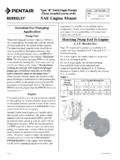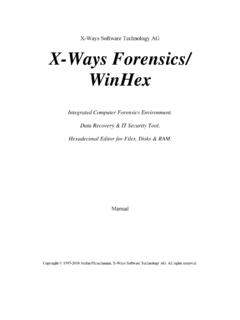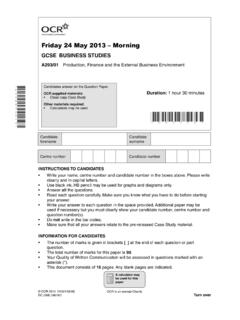Transcription of Buying a Used Shopsmith Mark V
1 Buying a used Shopsmith Mark V. A checklist to help you find the bargains and avoid the basketcases When search for tools, whether used or new, it's useful to keep your true goal in focus. No one buys tools because they want tools they want what tools can do. You are considering Buying a used Mark V because you want to remodel your home, build some new kitchen cabinets, make toys for the grandkids, or pursue some private vision of yourself as a skilled craftsman or creative artisan. Tools, especially good tools, will help you achieve these worthy ambitions and they are an essential ingredient for your eventual success, but they are not the only ingredient or even the most important.
2 What you need first and foremost is the knowledge to use these tools effectively. This is not just important, it's pivotal and that's why I've put it first on this checklist. You are considering Buying a Mark V because: You've heard it's a quality tool. It packs a lot of capability into a small space. Its unique design allows it to do many things other stand-alone tools can't. It's a great tool to learn on if you want to explore woodworking as a potential vocation or avocation. It's a decades-old tried-and-true woodworking system. The older machines are well-supported, serviceable, and upgradable. All of this is true, but I suggest you add one more item education.
3 Try to find a tool manufacturer that has authored more information about using its tools, or more know- how about the craft of woodworking. There are none that even come close to Shopsmith . A little history The Shopsmith 5-in-1 system was the brainchild of inventor Hans Goldschmidt who organized a company called Magna Engineering just after World War II. They released their first tool in 1947, the Shopsmith 10ER (Model 10, Experimental, Revised, in case you're wondering). It was well received, and Magna made dozens of improvements of the next 7 years, and in 1954 released the Shopsmith Mark V. Although there were other marks a Mark II and a Mark VII the Mark V was the flagship.
4 The design has been manufactured steadily by several companies since Magna, with well over a million sold. Although newer Shopsmiths look much the same as older ones, the design has not remained unchanged. There have been dozens of improvements made over the years, and you need to be aware of at least the most important of these as you shop for a used machine. Yes, you can update a 1954 Mark V to have all the same improvements and capabilities as one made this year. Yes, there are service parts and service people who can help you make the most hopeless basketcase useful and productive once again, but it will cost you.
5 And it may cost you many times the purchase price to restored an older machine that has not been well-cared for. So it's worth you while to take a good look under the hood and consider all the hidden expenses before you buy a used machine. Page 1 of 5. Breaking it down Because it's designed to do more than one operation, the Mark V is more complex than most consumer power tools. It helps to break the machine down into its component systems and consider each sub-system on its own, part by part. There are four of these sub-systems: Headstock, consisting of the motor, speed changer, arbors, and movable quill.
6 Main Table, consisting of the table, trunnions, carriage, and table-raising mechanism. Frame, consisting of legs, tubes, headrest, and pivoting base. Accessories, consisting of parts for each of the five functions sawing, drilling, boring, turning, and sanding as well as some accessories for extra support, safety, maintenance, and setup. Headstock The headstock contains an electrical motor with a non-standard mount and shaft you cannot go out a buy one of these off the shelf, so you want to be sure the one you get is in good shape. On the shaft of that motor are two floating sheaves (half-pulleys) and a V-belt that turns an idler shaft with two more floating sheaves.
7 The idler shaft turns the drive shaft at the top of the headstock via a flat belt. As you turn the speed changer, the sheaves on one shaft get closer together and the sheaves on the other get further apart. This changes the speeds at which all three of the power take-offs or arbors turn one at the end of the quill at the front of the headstock and two at the back. The quill extends and retracts from the headstock, like the quill of a drill press. Additionally, there is a switch to turn the motor off and on, and a headstock lock to secure it in position on the tubular frame. The Number One Thing to remember when looking over a used Shopsmith is don't turn the speed changer unless the motor is running.
8 If the seller adheres to the standard you break it; you bought it policy, you might find yourself the proud owner of the used Shopsmith in need of expensive repairs. Mark Vs made before 1962 (Serial No. 37143) have 3/4 horsepower motors;. those made afterwards have 1-1/8 horsepower. The extra oomph makes a big difference. Older machines bog down easier. You can install the more powerful motor, but they are costly. Prior to 1962 (Serial No. 37143), early headstocks used a toothed Gilmer drive belt between the idler and drive shafts. These are less durable the newer Poly- V belts. They are also less forgiving.
9 The poly-V belts will slip if there is some event that brings the drive train to a sudden halt; the Gilmer belts will not and internal parts may be damaged as a result. Early headstocks made in 1954 and 1955 had no access hole (covered by a Shopsmith logo) on the side of the headstock; making it extremely difficult to lubricate the interior parts of the speed changer and clean the teeth of the quill. You can have these holes machined, but that's another expense you may not want to shell out. Headstock made after 1984 (Serial ) have a two-bearing quill. These run smoother and have one-fifth the run-out as the older single-bearing quills, making it much easier to be accurate when drilling.
10 With 1988, Shopmith began using the date of manufacture as the serial number mm/dd/yyyy. Knowing that makes it easier to know the true age of a machine, Page 2 of 5. In 1991 (Serial No. 01011991), Shopsmith introduced a new headstock with a red safety switch, replacing the older toggle switch. Check that the speed changer and the sheaves move easily and are not frozen. Machines that have been mishandled by people who don't know enough not to turn the speed changer if the motor isn't running may have problems you don't want to seal with. Those that have not been properly lubricated or have been stored for a long time may have a jammed drive train.






